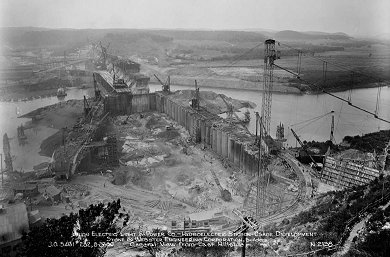Bagnell Dam
How the Osage Energy Center Works
The Osage Energy Center at Lake of the Ozarks is a major source of clean, renewable energy for Missouri customers. It also is integral to Ameren Missouri’s goal to achieve net-zero carbon emissions by 2050, which is why, in 2018, we completed $53 million in upgrades to ensure the safety, efficiency and reliability of the Bagnell Dam for many decades to come.
How does hydropower work? The Bagnell Dam holds back water from the Osage River to create the lake. This stored water serves as “fuel” for the Osage Energy Center, located inside the dam.
When the plant is operating, water flows from the lake through a large pipe called a penstock, which carries the water to large water wheels called turbines. Each turbine is connected to a generator, which a type of magnet spins inside a stationary coil of wire. As the pressure of water flowing through the plant turns the turbine, the turbine turns the magnet inside the generator, producing electricity.
When excess water flows into Lake of the Ozarks, such as during times of very heavy rainfall, the floodgates are used to pass this excess water downstream.
Did you know?
- Bagnell Dam was the largest - and last - major dam in the U.S. to be built with private investment.
- The Bagnell Dam actually got its name from a railroad man who formed his own town and then named it after himself. William Bagnell platted a town bearing his name on June 30, 1883.
- Bagnell Dam is one-half mile long, rising 148 feet high from bedrock. That’s comparable to a building 12 stories high and seven blocks long. It holds back 600 billion gallons of water.
- Ameren Missouri invested $53 million in upgrades at Bagnell Dam in 2017 and 2018, including 67 post-tensioned anchors and more than 66 million pounds of new concrete to weigh down the dam and secure it into the bedrock. The project created more than 200 construction jobs and an estimated $40 million in spending in the area.
- In a typical year, the Osage Energy Center produces more than 500 million kilowatthours of electricity - enough to supply the needs of nearly 42,000 average households.
- By using the natural energy of falling water, the Osage Energy Center saves our nation about one million barrels of oil or one million tons of coal each year.
- Missouri’s Lake of the Ozarks is one of the largest man-made lakes in the world, covering 86 square miles in four counties.
- Lake of the Ozarks is a little more than 100 feet deep at its deepest point. The lake level reading is the height of the surface of the lake above sea level. The full pool elevation of the lake is 660 feet above sea level.
Licensing information: FERC Order Approving License for Bagnell Dam and Osage Energy Center (PDF).
Lake Flood Level Guide Curves and Limits
Two significant floods in 2015 have caused many people to question whether anything has changed in how the Lake of the Ozarks (LOZ or Lake) levels are managed and whether that is resulting in more flooding on the Lake. The fact is that Lake level controls have changed and they can contribute to higher lake levels during flood events. This article will try to explain how levels are controlled and how floods are managed at the Lake of the Ozarks.

Bagnell Dam History
In 1912, Ralph W. Street of Kansas City first proposed damming the Osage River to generate electricity. However, it wasn’t until 1924 that Street and Walter Cravens, also of Kansas City, arranged financing and formed the Missouri Hydro-Electric Power Company.
The company began building roads, housing, an administration building, mess hall and other facilities needed to support construction of a dam near the tiny town of Bagnell. However, financial difficulties brought the project to a halt in 1926.
On July 27, 1929, Union Electric Company of St. Louis (now known as Ameren Missouri) purchased the facilities, and construction resumed on August 6. The New York Stock Exchange “crashed” two months later, bringing on the Great Depression, but work on the project continued. It became the only major construction project in the nation at the time, attracting thousands of workers from all over the country.
Records show more than 20,000 people worked on the project at one time or another. Although there were some steam shovels and other powered equipment, most labor was done by hand. Pay rates for construction workers were as low as 35 cents an hour. But during the Depression era, when a person could be hired for farm work for 50 cents a day, workers were glad to make the hourly wage.
The project was truly massive. Nearly 60,000 acres of land had to be acquired, and about 30,000 acres cleared of trees and brush. One million cubic yards of earth and rock had to be moved. Enough concrete was poured to build an 18-foot-wide highway from St. Louis to Topeka, Kansas. Enough carloads of material were used in the dam to fill a freight train stretching from St. Louis to Tulsa, Oklahoma.
Construction was completed two years after work began. Commercial operation of the Osage Power Plant began October 16, 1931.
At the time, Bagnell Dam was truly an engineering marvel, and dignitaries from all over the country and the world came to see it. Engineers proudly predicted the amount of electricity the Osage Power Plant would generate in future years, but no one dreamed of the millions of hours of recreation, Lake of the Ozarks would provide for tourists, local residents and second homeowners. Upgrades to the Bagnell Dam will enable it to continue to provide clean energy for the next 100 years.

